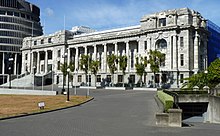| 25th Parliament of New Zealand | |||||||
|---|---|---|---|---|---|---|---|
| |||||||
 | |||||||
| Overview | |||||||
| Legislative body | New Zealand Parliament | ||||||
| Term | 25 March 1936 – 26 August 1938 | ||||||
| Election | 1935 New Zealand general election | ||||||
| Government | First Labour Government | ||||||
| House of Representatives | |||||||
 | |||||||
| Members | 80 | ||||||
| Speaker of the House | Bill Barnard | ||||||
| Prime Minister | Michael Joseph Savage | ||||||
| Leader of the Opposition | Adam Hamilton — George Forbes until 2 November 1936 | ||||||
| Legislative Council | |||||||
| Members | 39 (at start) 38 (at end) | ||||||
| Speaker of the Council | Sir Walter Carncross | ||||||
| Leader of the Council | Mark Fagan | ||||||
| Sovereign | |||||||
| Monarch | HM George VI — HM Edward VIII until 11 December 1936 | ||||||
| Governor-General | HE Rt. Hon. The Viscount Galway | ||||||
| Sessions | |||||||
| |||||||
The 25th New Zealand Parliament was a term of the New Zealand Parliament. It opened on 25 March 1936, following the 1935 election. It was dissolved on 16 September 1938 in preparation for the 1938 election.
The 25th Parliament was notable in that it was the first time the Labour Party had a parliamentary majority and formed a government, the First Labour Government. The new Prime Minister was Michael Joseph Savage. The opposition consisted of the United Party and the Reform Party, which merged to form the National Party in 1936.
The 25th Parliament consisted of eighty representatives, each elected from separate geographical electorates. As the 1935 elections had been a landslide victory for the Labour Party, the 25th Parliament was dominated by Labour MPs — 53 of the 80 were members of the Labour Party. The main opposition consisted of a coalition of the Reform Party, the United Party, and three independents, having a total of 19 MPs. Part way through the 25th Parliament, Reform and United took their coalition to the next step, and merged into a single group. This was called the National Party. The smaller Country Party and Rātana movement had two MPs each, and there were four independents not aligned with the coalition. The Democrat Party, despite winning a significant portion of the vote, did not hold any seats.